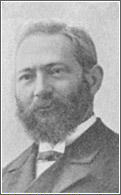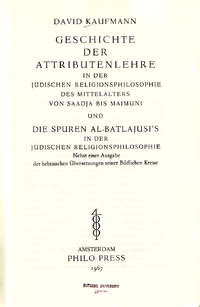
David Kaufmann
Encyclopedia

Kojetín
Kojetín is a Moravian town, in the Olomouc Region, the Czech Republic. It has 6,557 inhabitants.There are multiple pre-medieval historic records documenting existence and history of Kojetín in Czech and Moravian archives....
, Moravia
Moravia
Moravia is a historical region in Central Europe in the east of the Czech Republic, and one of the former Czech lands, together with Bohemia and Silesia. It takes its name from the Morava River which rises in the northwest of the region...
(now in the Czech Republic
Czech Republic
The Czech Republic is a landlocked country in Central Europe. The country is bordered by Poland to the northeast, Slovakia to the east, Austria to the south, and Germany to the west and northwest....
). From 1861 to 1867 he attended the gymnasium at Kroměříž
Kromeríž
Kroměříž is a town in the Zlín Region of the Czech Republic. The town's main landmark is the Baroque Kroměříž Bishop's Palace, where some scenes from Amadeus and Immortal Beloved were filmed...
, Moravia
Moravia
Moravia is a historical region in Central Europe in the east of the Czech Republic, and one of the former Czech lands, together with Bohemia and Silesia. It takes its name from the Morava River which rises in the northwest of the region...
, where he studied the Bible
Bible
The Bible refers to any one of the collections of the primary religious texts of Judaism and Christianity. There is no common version of the Bible, as the individual books , their contents and their order vary among denominations...
and Talmud
Talmud
The Talmud is a central text of mainstream Judaism. It takes the form of a record of rabbinic discussions pertaining to Jewish law, ethics, philosophy, customs and history....
with Jacob Brüll, rabbi of Kojetín, and with the latter's son Nehemiah.
His Life
In 1867 he went to the Jewish Theological Seminary at Breslau, where he studied for ten years, attending at the same time the university of that city. In the summer of 1874 he received his Ph.D. from the University of LeipzigUniversity of Leipzig
The University of Leipzig , located in Leipzig in the Free State of Saxony, Germany, is one of the oldest universities in the world and the second-oldest university in Germany...
, and on January 29, 1877, he was ordained rabbi. In the latter year he declined the offer of a professorship at the Jewish Theological Seminary
Jewish Theological Seminary of America
The Jewish Theological Seminary of America is one of the academic and spiritual centers of Conservative Judaism, and a major center for academic scholarship in Jewish studies.JTS operates five schools: Albert A...
, Cincinnati, preferring to accept instead the chairs of history, philosophy of religion, and homiletics at the newly founded Rabbinical Seminary of Budapest
Rabbinical Seminary of Budapest
The Rabbinical Seminary of Budapest was established in 1877 in Budapest, Hungary. The seminary was intended to serve as a modern institution of higher learning and was sponsored by the Hungarian government with the goal of instilling patriotism and spreading Hungarian culture among rabbinical...
, which he continued to hold till his death. He also at the same time taught Greek
Greek language
Greek is an independent branch of the Indo-European family of languages. Native to the southern Balkans, it has the longest documented history of any Indo-European language, spanning 34 centuries of written records. Its writing system has been the Greek alphabet for the majority of its history;...
and German
German language
German is a West Germanic language, related to and classified alongside English and Dutch. With an estimated 90 – 98 million native speakers, German is one of the world's major languages and is the most widely-spoken first language in the European Union....
in the preparatory school of the same institution, carrying on this work in the Hungarian language
Hungarian language
Hungarian is a Uralic language, part of the Ugric group. With some 14 million speakers, it is one of the most widely spoken non-Indo-European languages in Europe....
, which he had rapidly mastered.
As librarian of the seminary he acquired the large library of Lelio della Torre of Padua
Padua
Padua is a city and comune in the Veneto, northern Italy. It is the capital of the province of Padua and the economic and communications hub of the area. Padua's population is 212,500 . The city is sometimes included, with Venice and Treviso, in the Padua-Treviso-Venice Metropolitan Area, having...
, the library of the seminary becoming by this addition one of the most valuable Hebrew libraries of Europe. As a teacher Kaufmann was highly successful; and his relation to his students was that of friendly adviser. He maintained a lively correspondence not only with the most eminent Jewish scholars, but also with the leaders in other branches of science. Kaufmann was a corresponding member of the Royal Academy of Sciences of Madrid
Madrid
Madrid is the capital and largest city of Spain. The population of the city is roughly 3.3 million and the entire population of the Madrid metropolitan area is calculated to be 6.271 million. It is the third largest city in the European Union, after London and Berlin, and its metropolitan...
and a member of the executive committee of the Budapest branch of the Alliance Israélite Universelle. He died at Karlovy Vary
Karlovy Vary
Karlovy Vary is a spa city situated in western Bohemia, Czech Republic, on the confluence of the rivers Ohře and Teplá, approximately west of Prague . It is named after King of Bohemia and Holy Roman Emperor Charles IV, who founded the city in 1370...
, Bohemia
Bohemia
Bohemia is a historical region in central Europe, occupying the western two-thirds of the traditional Czech Lands. It is located in the contemporary Czech Republic with its capital in Prague...
, on July 6, 1899.
His Works

- Die Theologie des Bachja ibn Pakuda, Verfasser des חובות הלבבות, a prize essay written while a student at the seminary (in Berichte der Kaiserlichen Akademie der Wissenschaften, Vienna, 1874)
- Geschichte der Attributenlehre in der Jüdischen Religionsphilosophie des Mittelalters von Saadia bis Maimuni (Gotha, 1877–78), his chief work, being a survey of the Jewish and Arabic religious philosophy of the Middle AgesMiddle AgesThe Middle Ages is a periodization of European history from the 5th century to the 15th century. The Middle Ages follows the fall of the Western Roman Empire in 476 and precedes the Early Modern Era. It is the middle period of a three-period division of Western history: Classic, Medieval and Modern...
- Die Spuren al-Batlajusi's in der Jüdischen Religionsphilosophie Nebst einer Ausgabe der Hebr. Uebersetzung Seiner Bildlichen Kreise (Budapest, 1880; also in Hungarian)
- Die Sinne. Beiträge zur Geschichte der Physiologie und Psychologie im Mittelalter. Aus Hebräischen und Arabischen Quellen (Budapest, 1884; also in Hungarian)
- an edition of the Minḥat Ḳena'ot of Jehiel ben Samuel PisaJehiel ben Samuel PisaJehiel of Pisa was a philanthropist and scholar of Pisa. The wealth he had acquired in the banking business he spent liberally for charitable purposes. Himself a scholar, he extended his protection to Jewish learning. Johanan Alemanno, the teacher of Pico di Mirandola, seems to have lived for...
(Berlin, 1898, forming a part of the Meḳiẓe Nirdamim collection) - Studien über Salomon ibn Gabirol (Budapest, 1899; also in Hungarian)
- a large number of essays in various periodicals, noteworthy among which is the paper Der Führer Maimuni's in der Weltlitteratur (reprinted from Archiv für Geschichte der Philosophie, by L. Stein, xi., No. 3).
Contributions to Jewish History
His most important historical monographs are:- Die Letzte Vertreibung der Juden aus Wien, Ihre Vorgeschichte (1625–70) und Ihre Opfer (Vienna, 1889; also in Hungarian)
- Zur Gesch. Jüdischer Familien: Samson Wertheimer, der Oberhoffactor und Landesrabbiner, 1658–1724, und Seine Kinder (Vienna, 1888)
- Urkundliches aus dem Leben Samson Wertheimers (Budapest, 1891; also in Hungarian)
- Die Familien Prags nach den Epitaphien des Alten Jüdischen Friedhofs in Prag, Zusammengestellt von Simon Hock, aus Dessen Nachlasse Herausgegeben, mit Anmerkungen Versehen und Biographisch Eingeleitet von Prof. Dr. D. Kaufmann (with Hebrew title-page, Presburg, 1892)
- Zur Gesch. Jüdischer Familien: I., R. Jair Chajjim Bacharach, 1638–1702, und Seine Ahnen (Treves, 1894)
- Dr. Israel Conegliano und Seine Verdienste um die Republik Venedigbis nach dem Frieden von Carlowitz (Budapest, 1895; also in Hungarian)
- Die Erstürmung Ofens und Ihre Vorgeschichte nach dem Berichte Isaak Schulhofs [Megillat Ofen], 1650–1732; Herausgegeben und Biographisch Eingeleitet (Treves, 1895)
- Aus Heinrich Heine's Ahnensaal (Breslau, 1896)
- Die Memoiren der Glückel von Hameln (Frankfort-on-the-Main, 1896, with Hebrew title-page);
- Die Chronik des Achimaaz aus Oria (reprint from "Monatsschrift," 1896).
On Jewish Art
Kaufmann was the first to take up the history of art in the synagogue. The following works of his in this field may be mentioned:- Zur Gesch. der Kunst in den Synagogen (Vienna, 1897)
- Zur Gesch. der Jüdischen Handschriften-Illustration (contribution. to the édition de luxe of the Sarajevo HaggadahSarajevo HaggadahThe Sarajevo Haggadah is an illuminated manuscript that contains the illustrated traditional text of the Passover Haggadah which accompanies the Passover Seder. It is one of the oldest Sephardic Haggadahs in the world, originating in Barcelona around 1350. The Haggadah is presently owned by the...
by D. H. Müller and I. v. Schlossar, Vienna, 1898) - Sens et Origines des Symboles Tumulaires de l'Ancien Testament dans l'Art Chrétien Primitif (R. E. J. xiv. 33, 217).
Kaufmann also polemized much in behalf of Judaism. Noteworthy among his writings along this line are:
- Ein Wort im Vertrauen an Herrn Hofprediger Stöcker yon Einem, Dessen Name Nichts zur Sache Thut (Berlin, 1880)
- Paul de Lagarde's Jüdische Gelehrsamkeit (Leipsic, 1887), a defense of his friend and master ZunzZunzZunz, Zuntz is a Yiddish surname: , Belgian pharmacologist* Leopold Zunz , German Reform rabbi* Gerhard Jack Zunz , British civil engineer- Zuntz :* Nathan Zuntz , German physiologist...
- Wie Heben Wir den Religiösen Sinn Unserer Mädchen und Frauen (Treves, 1893)
- introduction to S. Heller's Die Echten Hebräischen Melodien (ib. 1893)
He was also an active member of the Meḳiẓe Nirdamim, a society for the publication of old Hebrew manuscripts. Kaufmann was the possessor of a large library, which contained many valuable manuscripts, incunabula, and first editions, and of which the Marco Mortara
Marco Mortara
Marco Mortara Marco Mortara Marco Mortara (born at Viadana, 7 May 1815; died at Mantua, 2 February 1894 was an Italian rabbi and scholar.Having graduated from the rabbinical college of Padua in 1836, he was called as rabbi to Mantua in 1842, and occupied this position until his death...
library, acquired by Kaufmann, formed the nucleus.
Jewish Encyclopedia bibliography
An entire Kaufmann literature has arisen, of which the following works may be mentioned:- F. Rosenthal, biography in the Kaufmann Gedenkbuch;
- Samuel KraussSamuel KraussSamuel Krauss was professor at the Jewish Teachers' Seminary, Budapest, 1894–1906, and at the Jewish Theological Seminary, Vienna, 1906-1938. He came to England as a refugee and spent his last years at Cambridge.He was a contributor to the Jewish Encyclopedia as S...
, David Kaufmann, Berlin, 1902; - H. Bloch, in Abendblatt of the Pester Lloyd, July 10, 1899;
- D. H. Müller, in Jahrb. des Vereines für Jüd. Gesch. und Literatur, Berlin, 1900;
- L. Blau, in Jahresbericht der Landesrabbinerschule, 1900.
External links
- Jewish Encyclopedia article for David Kaufmann, by Isidore SingerIsidore SingerIsidore Singer was an editor of the Jewish Encyclopedia and founder of the American League for the Rights of Man.-Biography:...
and Max Weisz. - A thorough survey about David Kaufmann and his collection.

